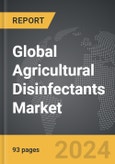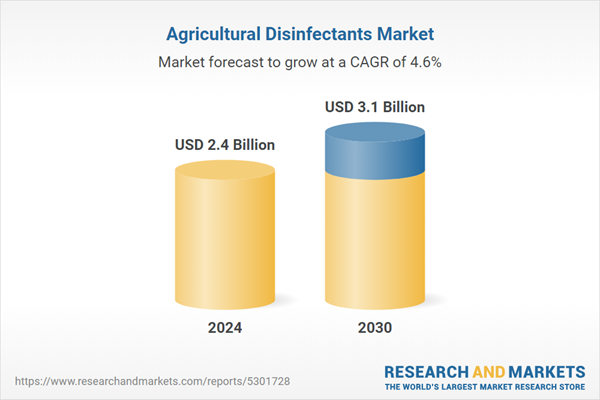The global market for Agricultural Disinfectants was valued at US$2.4 Billion in 2024 and is projected to reach US$3.1 Billion by 2030, growing at a CAGR of 4.6% from 2024 to 2030. This comprehensive report provides an in-depth analysis of market trends, drivers, and forecasts, helping you make informed business decisions. The report includes the most recent global tariff developments and how they impact the Agricultural Disinfectants market.
Segments: Type (Quaternary Ammonium Compounds & Phenols, Hypochlorites & Halogens, Oxidizing Agents & Aldehydes, Other Types); Form (Liquid, Powder, Other Forms); Application (Surface, Aerial, Water Sanitizing); End-Use (Livestock Farms, Agricultural Farms).
Geographic Regions/Countries: World; United States; Canada; Japan; China; Europe (France; Germany; Italy; United Kingdom; Spain; Russia; and Rest of Europe); Asia-Pacific (Australia; India; South Korea; and Rest of Asia-Pacific); Latin America (Argentina; Brazil; Mexico; and Rest of Latin America); Middle East (Iran; Israel; Saudi Arabia; United Arab Emirates; and Rest of Middle East); and Africa.
The analysts continuously track trade developments worldwide, drawing insights from leading global economists and over 200 industry and policy institutions, including think tanks, trade organizations, and national economic advisory bodies. This intelligence is integrated into forecasting models to provide timely, data-driven analysis of emerging risks and opportunities.
Global Agricultural Disinfectants Market - Key Trends and Drivers Summarized
Why Are Agricultural Disinfectants Crucial for Farm Biosecurity?
Agricultural disinfectants play a pivotal role in maintaining farm biosecurity, protecting crops and livestock from harmful pathogens that can compromise productivity and safety. In modern agriculture, the need for stringent sanitation practices is more critical than ever, as farms are increasingly vulnerable to the spread of diseases caused by bacteria, viruses, fungi, and parasites. These pathogens can rapidly multiply and spread across fields, barns, and equipment, leading to devastating losses in both plant and animal farming operations. Agricultural disinfectants are specially formulated chemical agents designed to kill or inhibit these microorganisms, thereby reducing the risk of disease outbreaks. They are applied to various surfaces, including farming equipment, livestock housing, greenhouses, and storage facilities, creating a clean and pathogen-free environment. By eliminating disease-causing organisms, disinfectants ensure healthier plants and animals, reduce mortality rates, and contribute to the overall sustainability and profitability of farming operations.How Do Agricultural Disinfectants Improve Farm Efficiency?
Agricultural disinfectants enhance farm efficiency by preventing the onset and spread of infectious diseases, which can significantly disrupt farming operations. Disease outbreaks in plants, for example, can lead to the loss of entire crops, while in livestock, infections can cause decreased productivity, reduced meat or milk yields, and even large-scale animal culling. Regular disinfection of farm infrastructure helps to minimize these risks by creating a healthier environment for both plants and animals. For crop farmers, disinfectants can be used in greenhouses and storage units to prevent fungal infections like mildew and mold, which can damage crops post-harvest. Livestock farmers use disinfectants to clean pens, feeding equipment, and water systems, ensuring animals are not exposed to harmful pathogens that can cause respiratory illnesses, digestive problems, or foot and mouth disease. This preventative approach not only protects farm output but also reduces the reliance on antibiotics and pesticides, supporting more sustainable farming practices. Moreover, by reducing disease pressures, disinfectants enable more efficient use of resources, as farmers can allocate their time and efforts to production rather than dealing with the consequences of outbreaks.What Are the Emerging Trends in Agricultural Disinfectants?
The agricultural disinfectants market is undergoing significant innovation, driven by advancements in technology, increasing regulatory requirements, and growing awareness of environmental sustainability. One notable trend is the shift toward eco-friendly disinfectants that minimize harmful residues and reduce environmental impact. Traditional disinfectants, while effective, often contain harsh chemicals that can persist in the environment, affecting soil health and water quality. In response, companies are developing biodegradable and less toxic alternatives, such as hydrogen peroxide-based or natural plant-extract disinfectants, which are safer for the environment and leave fewer residues on surfaces. Another key trend is the growing use of precision agriculture technologies to optimize the application of disinfectants. Technologies such as automated spraying systems and drones allow farmers to apply disinfectants more efficiently, targeting specific areas that require sanitation and reducing waste. Additionally, innovations in nanotechnology are influencing the development of agricultural disinfectants, with nano-sized particles offering more effective penetration and long-lasting protection against pathogens. As biosecurity threats become more sophisticated, farmers are increasingly relying on these advanced disinfectant solutions to safeguard their operations from disease outbreaks.What Is Driving the Growth of the Agricultural Disinfectants Market?
The growth in the agricultural disinfectants market is driven by several key factors, including increasing concerns over biosecurity, rising consumer demand for food safety, and regulatory pressures. As global food production intensifies to meet the demands of a growing population, the need to protect crops and livestock from disease outbreaks has become a top priority for farmers. Diseases that affect livestock, such as avian influenza and African swine fever, can lead to catastrophic losses, prompting farmers to invest more heavily in biosecurity measures like disinfectants. Similarly, crop diseases, which can spread through soil, water, and equipment, are a constant threat, making disinfectant use essential for protecting harvests. Another significant driver is the rising consumer demand for safer, chemical-free food products, which is encouraging farmers to adopt disinfectants that are effective without leaving harmful residues. This trend aligns with the broader movement toward organic and sustainable farming practices. Furthermore, governments and international bodies are imposing stricter regulations on farm sanitation and biosecurity, particularly in response to the global spread of zoonotic diseases that can transfer from animals to humans. Compliance with these regulations is pushing farmers to increase their use of disinfectants to meet food safety standards and protect public health. Finally, technological advancements in disinfectant formulation and application are making it easier and more cost-effective for farmers to integrate these products into their daily operations, further driving market growth. These factors collectively ensure that the demand for agricultural disinfectants will continue to rise as farms prioritize health, safety, and sustainability in their production processes.Report Scope
The report analyzes the Agricultural Disinfectants market, presented in terms of units. The analysis covers the key segments and geographic regions outlined below.Segments: Type (Quaternary Ammonium Compounds & Phenols, Hypochlorites & Halogens, Oxidizing Agents & Aldehydes, Other Types); Form (Liquid, Powder, Other Forms); Application (Surface, Aerial, Water Sanitizing); End-Use (Livestock Farms, Agricultural Farms).
Geographic Regions/Countries: World; United States; Canada; Japan; China; Europe (France; Germany; Italy; United Kingdom; Spain; Russia; and Rest of Europe); Asia-Pacific (Australia; India; South Korea; and Rest of Asia-Pacific); Latin America (Argentina; Brazil; Mexico; and Rest of Latin America); Middle East (Iran; Israel; Saudi Arabia; United Arab Emirates; and Rest of Middle East); and Africa.
Key Insights:
- Market Growth: Understand the significant growth trajectory of the Quaternary Ammonium Compounds & Phenols segment, which is expected to reach US$1.2 Billion by 2030 with a CAGR of a 5.5%. The Hypochlorites & Halogens segment is also set to grow at 4.0% CAGR over the analysis period.
- Regional Analysis: Gain insights into the U.S. market, valued at $627.3 Million in 2024, and China, forecasted to grow at an impressive 7.5% CAGR to reach $706.5 Million by 2030. Discover growth trends in other key regions, including Japan, Canada, Germany, and the Asia-Pacific.
Why You Should Buy This Report:
- Detailed Market Analysis: Access a thorough analysis of the Global Agricultural Disinfectants Market, covering all major geographic regions and market segments.
- Competitive Insights: Get an overview of the competitive landscape, including the market presence of major players across different geographies.
- Future Trends and Drivers: Understand the key trends and drivers shaping the future of the Global Agricultural Disinfectants Market.
- Actionable Insights: Benefit from actionable insights that can help you identify new revenue opportunities and make strategic business decisions.
Key Questions Answered:
- How is the Global Agricultural Disinfectants Market expected to evolve by 2030?
- What are the main drivers and restraints affecting the market?
- Which market segments will grow the most over the forecast period?
- How will market shares for different regions and segments change by 2030?
- Who are the leading players in the market, and what are their prospects?
Report Features:
- Comprehensive Market Data: Independent analysis of annual sales and market forecasts in US$ Million from 2024 to 2030.
- In-Depth Regional Analysis: Detailed insights into key markets, including the U.S., China, Japan, Canada, Europe, Asia-Pacific, Latin America, Middle East, and Africa.
- Company Profiles: Coverage of players such as Ceva Sante Animale Group, Chemours Company, Dow Chemical Company, Entaco NV, FINK TEC GmbH and more.
- Complimentary Updates: Receive free report updates for one year to keep you informed of the latest market developments.
Some of the 37 companies featured in this Agricultural Disinfectants market report include:
- Ceva Sante Animale Group
- Chemours Company
- Dow Chemical Company
- Entaco NV
- FINK TEC GmbH
- Lanxess AG
- Neogen Corporation
- Nufarm Limited
- Quat-Chem Ltd.
- Shandong Daming Disinfection Technology Co., Ltd.
- Stepan Company
- Thymox Technology
- Zoetis
Tariff Impact Analysis: Key Insights for 2025
Global tariff negotiations across 180+ countries are reshaping supply chains, costs, and competitiveness. This report reflects the latest developments as of April 2025 and incorporates forward-looking insights into the market outlook.The analysts continuously track trade developments worldwide, drawing insights from leading global economists and over 200 industry and policy institutions, including think tanks, trade organizations, and national economic advisory bodies. This intelligence is integrated into forecasting models to provide timely, data-driven analysis of emerging risks and opportunities.
What’s Included in This Edition:
- Tariff-adjusted market forecasts by region and segment
- Analysis of cost and supply chain implications by sourcing and trade exposure
- Strategic insights into geographic shifts
Buyers receive a free July 2025 update with:
- Finalized tariff impacts and new trade agreement effects
- Updated projections reflecting global sourcing and cost shifts
- Expanded country-specific coverage across the industry
Table of Contents
I. METHODOLOGYII. EXECUTIVE SUMMARY2. FOCUS ON SELECT PLAYERSIII. MARKET ANALYSISCANADAITALYSPAINRUSSIAREST OF EUROPESOUTH KOREAREST OF ASIA-PACIFICARGENTINABRAZILMEXICOREST OF LATIN AMERICAIRANISRAELSAUDI ARABIAUNITED ARAB EMIRATESREST OF MIDDLE EASTIV. COMPETITION
1. MARKET OVERVIEW
3. MARKET TRENDS & DRIVERS
4. GLOBAL MARKET PERSPECTIVE
UNITED STATES
JAPAN
CHINA
EUROPE
FRANCE
GERMANY
UNITED KINGDOM
ASIA-PACIFIC
AUSTRALIA
INDIA
LATIN AMERICA
MIDDLE EAST
AFRICA
Companies Mentioned (Partial List)
A selection of companies mentioned in this report includes, but is not limited to:
- Ceva Sante Animale Group
- Chemours Company
- Dow Chemical Company
- Entaco NV
- FINK TEC GmbH
- Lanxess AG
- Neogen Corporation
- Nufarm Limited
- Quat-Chem Ltd.
- Shandong Daming Disinfection Technology Co., Ltd.
- Stepan Company
- Thymox Technology
- Zoetis
Table Information
| Report Attribute | Details |
|---|---|
| No. of Pages | 93 |
| Published | April 2025 |
| Forecast Period | 2024 - 2030 |
| Estimated Market Value ( USD | $ 2.4 Billion |
| Forecasted Market Value ( USD | $ 3.1 Billion |
| Compound Annual Growth Rate | 4.6% |
| Regions Covered | Global |









